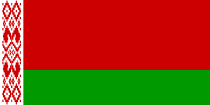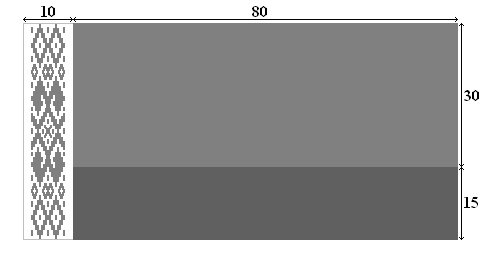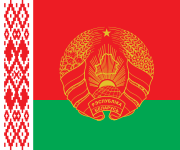Flag of Belarus
 |
|
| Use | National flag |
|---|---|
| Proportion | 1:2 |
| Adopted | June 7, 1995 |
| Design | A horizontal bicolor of red over green in a 2:1 ratio, with a red ornamental pattern on a white vertical stripe at the hoist |
The current national flag of Belarus (Belarusian: Сцяг Беларусі, Stsyah Byelarusi; Russian: Флаг Беларуси, Flag Belarus) was formally adopted on June 7, 1995, following the result of a referendum voted on by the Belarusian people in the previous month. This new design replaced a historical flag used by the Belarusian People's Republic of 1918, before Belarus became a Soviet Republic, and again after it regained its independence in 1991. The current flag is a modification of the 1951 flag used while the country was a republic of the Soviet Union. Several flags used by government officials and agencies were based on the national flag.
A few groups have continued to use the white and red flag, though its display in Belarus has been restricted by the government of Belarus due to its association with Nazi collaboration during the Second World War. That flag is used in protests against the government and by certain elements of Belarusian diaspora.
Contents |
Design
The national flag of Belarus, as described in a decree on June 7, 1995, :
| “ | The national flag is a rectangular cloth consisting of two longitudinal stripes: red upper stripe and green lower stripe that are two-thirds and one-third of the flag width respectively. A vertical red-on-white Belarusian decorative pattern, which occupies one-ninth of the flag's length, is placed against the flagstaff. The flag’s ratio of width to length is 1:2. The flag is fixed on a flagstaff painted golden (ochre). | ” |
The flag does not differ significantly from the flag of the Byelorussian SSR, other than the removal of the hammer and sickle and the red star, and the reversal of red and white in the hoist pattern.[1] The red color of the flag signifies the past history of Belarus, as the color used by the Belarusian forces at the Battle of Grunwald, and of the Red Army when they were fighting Nazi Germany during World War II. Green stands for aspirations about the future, and also represents the many forests located in the country.
In addition to the decree, "STB 911-2008: National Flag of the Republic of Belarus," released by the State Committee for Standardization of the Republic of Belarus in 2008. It gives the technical specifications of the national flag, such as the details of the colors and the ornamment pattern. The ornament pattern on the national flag is 1/12th the width of the flag. At the hoist of the flag, there is a thin red line that separates the flag with the sleeve used for putting flags on poles or staff. The width of thered line is 1/21 of the white bar that has the ornament.[2]

Colors
The colors of the national flag are regulated in the document "STB 911-2008: National Flag of the Republic of Belarus," released by the State Committee for Standardization of the Republic of Belarus. The colors are listed in the CIE Standard illuminant D65.[2]
| Color | Color Coordinate | Y10 | |
|---|---|---|---|
| x10 | y10 | ||
| Red | 0.553 ± 0.010 | 0.318 ± 0.010 | 14.8 ± 1.0 |
| Green | 0.297 ± 0.010 | 0.481 ± 0.010 | 29.6 ± 1.0 |
Hoist ornament pattern
A decorative pattern, designed in 1917 by Matrena Markevich, is displayed on the hoist of the flag (and previously on the 1951 flag). The pattern is of a traditional kind commonly used in Belarus which is derived from local plants and flowers. These patterns are sometimes used in woven garments, but most importantly in the traditional 'rushnik' – a woven towel used for ceremonial events like religious services, funerals, and other social functions. An example of their use would be a host offering his guests bread and salt served on a rushnik.[3] On the current flag, the ornamentation is used to symbolize the cultural past, and current Belarusian unity.
Finial
A flag finial is an ornament that is placed on top of the flagstaff as a piece of decoration. Belarusian law states that if the flag is used by government bodies for certain occasions, such as ceremonies and other solemn events, the Belarusian flag is to be topped with a finial, diamond-shaped with a gold star attached to the bottom. The star, according to law, has five points and must be of the same design as the one in the Belarusian coat of arms.[1] The entire finial is of a golden color with a golden shaft where the finial can be mounted on the flagpole. If the flag belongs to a military organization, ribbons can be placed on this golden shaft.
Proper flag protocol
.jpg)
.gif)
By law, the Belarusian flag is supposed to be flown daily, weather permitting, from the following locations:
- National Assembly of Belarus
- Council of Ministers of Belarus
- Courts of Belarus, and offices of local executive and administrative bodies
- Above buildings in which sessions of local Councils of deputies are carried out
- Military bases or military ships owned by the government
- Buildings used by Belarusian diplomats
The Belarusian flag is also officially flown on these occasions:
- Sessions of local executive and administrative bodies
- Voting/polling places
- Sports arenas during competitions (note that the IOC has its own rules on flag display)
The flag is also displayed on vehicles used by Belarusian diplomats and various government officials (such as the President and the Prime Minister).
The law allows for the flag to be used for special occasions, such as memorial services, and family holidays, and it can be used by various groups of people, such as public organizations, companies, and NGOs. The regulations were issued in the same decree that created the Belarusian flag. May 15 has been declared the Day of the National Emblem and Flag of Belarus (День Государственного герба и Государственного флага Республики Беларусь).[4] The national flag itself has been incorporated into the badge of the guard units in the Belarusian armed forces.[5] The relation of the width of the state flag to the length of the pole that it is used is at minimum 1 to 3.[6]
Historical flags
The Soviet flag of 1951

The flag of the Byelorussian Soviet Socialist Republic was adopted by decree on December 25, 1951.[7]
The flag had a length to width ratio of one to two (1:2), just like the flag of the Soviet Union (and the other fourteen union republics). The main portion of the flag was red (representing the Revolution), with the rest being green (representing the Belarusian forests). A pattern of white drawn on red decorated the hoist portion of the flag; this design is often used on Belarusian traditional costumes. In the upper corner of the flag, in the red portion, a gold hammer and sickle was added, with a red star outlined in gold above it. The hammer represented the worker, and the sickle the peasant; according to Soviet ideology, these two symbols crossed together symbolized co-operation between the two classes. The red star, a symbol commonly used by Communist parties, was said to stand either for the five social groups (workers, youth, peasants, military, and academics), the five known continents, or the five fingers of the worker's hand. The hammer, sickle and star were sometimes not displayed on the reverse of the flag.
Previous flags of the Soviet era
Before 1951, several different flags had been in use since the Revolution. The earliest flag was plain red, and was used in 1919 during the existence of the Lithuanian-Byelorussian SSR. After the formation of the Byelorussian SSR, the lettering ССРБ (SSRB) was added in gold to the top hoist. This design was changed in 1937, when a hammer and sickle and red star were placed above the letters; at the same time, the typeface was changed, and the text of the lettering was altered to БССР (BSSR). During the 1940s, the hammer and sickle and red star were removed from the flag, and a gold border was added to the letters. This flag remained in use until the adoption of the 1951 flag.
 1919 |
.svg.png) 1919 to 1937 |
.svg.png) 1937 to 1940s |
.svg.png) 1940s to 1951 |
The white-red-white flag
.svg.png)
The design of the flag used between 1991 and 1995 is believed to have been created by Klaudzi Duzh-Dusheuski before 1917 and had originally been devised by the Belarusian People's Republic (March to December 1918). This flag design is known in Belarusian as the Бел-чырвона-белы сьцяг (bieł-čyrvona-bieły ściah).
Red and white have traditionally been used in state heraldry of the Grand Duchy of Lithuania and the Polish–Lithuanian Commonwealth. The colors base on those of the coat of arms Pahonia that was a traditional coat of arms of Belarusian lands and had a white horseman on a red background.
There are several other theories explaining the flag's origin. One theory speaks of an allusion to the name of the country: White Russia. Another theory, which is also the traditional explanation, is that in 1410, when the united armies of Poland and the Grand Duchy of Lithuania, defeated the Germans of the Teutonic Order at the Battle of Grunwald. According to this tradition, a wounded Belarusian knight tore off a blood soaked bandage and raised it as a banner of victory; this story is similar to the traditional accounts of the origins of the flag of Austria and the flag of Latvia, which both are red-white-red.
Variations of this flag were used during the Belarusian People's Republic. Lasting from 1919 until 1925, the flag of the BPR retained white, red, white design, but with the addition of black stripes at the top and bottom of the red stripe.
Between 1921 and 1939 the white-red-white flag was used by the Belarusian national movement in West Belarus (part of the Second Polish Republic), both by political organizations like the Belarusian Peasants' and Workers' Union or the Belarusian Christian Democracy, and non-political organizations like the Belarusian Schools Society.[8] The flag was also used by the Belarusian Special Battalion in the army of the Republic of Lithuania. After the reunification of Belarus in 1939 the flag was forbidden by the Soviet administration in West Belarus as well.
In 1941 the flag was allowed for usage by the Nazi occupation administration, and it appeared on arm patches of Belarusian volunteers in the German Army and Waffen SS and was used by the Belarusian Central Rada, the pro-German government of Belarus in 1943-1944.
After the end of World War 2 the flag was used by Belarusian diaspora in the West and by small groups of anti-Soviet resistance in Belarus itself.
In late 1980s the flag was again used as a symbol of national revival and democratic changes in Belarus. By proposal of the Belarusian Popular Front the flag became state symbol of Belarus upon its regaining of independence in 1991.
Use of the flag since 1995
From 1991 until the controversial referendum in 1995, the white-red-white flag was used as the national flag. However, despite the adoption of new national symbols after the referendum, the flag has continued to be used both inside and outside of Belarus. Currently, the flag is often used as a symbol of protest against President Lukashenko's government. However, any display of the flag in Belarus is usually removed by local police. For instance, activist Kristina Shatikova was beaten by the police and fined for using the flag in Vitsebsk.[9]
Some of the groups using this flag as a protest include Zubr and the Belarusian Popular Front.[10] The official reason for outlawing the white-red-white flag is that the symbol was used by the Nazi collaborators during the World War II.[11] This is the flag used by the Belarusian diaspora worldwide.
The 1995 referendum

The referendum that was held to adopt the state symbols took place on May 14, 1995. With a voter turnout of 64.7%, the new flag was approved by a majority in the ratio of three to one (75.1% to 24.9%). The other three questions were also passed by the voters. The way of carrying out the referendum as well as legality of questioning the national symbols on a referendum was heavily criticized by the opposition[12] 48.6% of the total eligible electorate approved of the new emblem, since over a third of the eligible voters did not express an opinion. Some claim that this failure to win a majority is a violation of the Law, but the Constitution of Belarus doesn't state the required number of citizens to vote in order for a result to become valid.
President Lukashenko had tried to hold a similar referendum before, in 1993, but failed to get parliamentary support. Two months before the May 1995 referendum, Lukashenko proposed a flag design that consisted of two small bars of green and one wide bar of red. While it is not known what became of this suggestion, new designs (called "projects" in Belarus) were suggested a few days later, which were then put up to vote in the 1995 referendum.[13]

Since the introduction of the 1995 flag, several other flags adopted by government agencies or bodies have been modeled on it.
President Lukashenko has adopted a standard for his personal use. The standard, which has been in use since 1997, was adopted by a decree called "Concerning the Standard of the President of Republic of Belarus". The standard's design is an exact copy of the national flag, with the addition of the Belarusian national emblem in gold and red. The standard's ratio of 5:6 differs from that of the national flag, making the standard almost square. It is used at buildings and on vehicles to denote the presence of the president.[14]
In 2001, President Lukashenko issued a decree granting a flag to the Armed Forces of Belarus. The flag, which has a ratio of 1:1.7, has the national ornamental pattern along the length of the hoist side of the flag. On the front of the flag is the Belarusian coat of arms, with the wording УЗБРОЕНЫЯ СІЛЫ ("Armed Forces") arched over it, and РЭСПУБЛІКІ БЕЛАРУСЬ ("of Republic of Belarus") written below; the text of both is in gold. On the reverse of the flag, the center contains the symbol of the armed forces, which is a red star surrounded by a wreath of oak and laurel. Above the symbol is the phrase ЗА НАШУ РАДЗІМУ ("For our Motherland"), while below is the full name of the military unit.[15]
References
- ↑ 1.0 1.1 "National Symbols" page on the official website of the President of Belarus
- ↑ 2.0 2.1 2.2 "STB 911-2008: National Flag of the Republic of Belarus. Technical Specifications." (in Russian). State Committee for Standardization of the Republic of Belarus. 2008.
- ↑ "Belarusian Textiles" and "Belarusian Ruchnik" pages on the Virtual Guide to Belarus website
- ↑ (Russian) BelTA's page about the national flag day
- ↑ (Russian) Badges of the Armed Forces of Belarus Note: Works in Internet Explorer only
- ↑ "Государственные символы Республики Беларусь" (in Russian). Национальный центр правовой информации Республики Беларусь. http://mir.pravo.by/library/adres/gosydarstvensimvol/. Retrieved 2010-04-30.
- ↑ Flags of the World page "Belarus in the Soviet Union"
- ↑ (Belarusian)Андрэй Вашкевіч. Нашы сьцягі над Заходняй // Arche, №4 (55) - 2007
- ↑ United Civil Party of Belarus Revolt in Vitsebsk. Authored by UCP Press. Published June 22, 2006.
- ↑ (Belarusian) Webpage showing photos of the white-red-white flag being used by the group Zubr
- ↑ (Russian) Webpage showing details of uniforms and insignia of the BKA
- ↑ Official Results
- ↑ (Russian) Vexillographia page "Государственный флаг Республики Беларусь"
- ↑ (Russian) Decree dated March 27, 1997, creating the presidential standard
- ↑ Flags of the World page "Belarus - Military Flags", and (Russian) Vexillographia page "Флаги армии Беларуси"
External links
- Official site of the President of the Republic of Belarus - Official description of the National Symbols
- Belarus at Flags of the World
- Vexillographia - Flags of Belarus (Russian)
|
|||||
|
|||||||||||||||||
|
||||||||